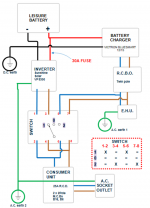UsedtobeGinger
Forum Member
Hi, seems like a jolly place - are there any electrical experts on here?
I have a self-build Relay, installed ,most electrics about 3 years ago. I put in EHU (with a consumer unit including 2-pole RCD) with a single outlet socket, solar panels, lots of other stuff. I did not put in an inverter, as I didn't really need 230V off-grid for anything.
Anyhow, time moves on and I am working from the van on occasion, and would like to charge my laptop when off-grid, so am looking to install a low power inverter to supply the aforementioned AC outlet socket. As far as I can tell, there are a couple of ways I could do this safely - with the main things being to a) keep the EHU and Inverter AC supplies isolated (I am proposing to use a manual switch) and b) avoid the possibility of my leisure battery charger from being supplied by the Inverter output.
Re the two options in the diagrams attached, does anyone:
1) have any comments on safety issues? - I am not totally sure about avoiding earthing loops and whether / where neutral-earth bonding might be necessary
2) think there would be any other advantages to either option?
Thanks in advance for any constructive comments - including if you point out any howling errors in my diagrams!!
I have a self-build Relay, installed ,most electrics about 3 years ago. I put in EHU (with a consumer unit including 2-pole RCD) with a single outlet socket, solar panels, lots of other stuff. I did not put in an inverter, as I didn't really need 230V off-grid for anything.
Anyhow, time moves on and I am working from the van on occasion, and would like to charge my laptop when off-grid, so am looking to install a low power inverter to supply the aforementioned AC outlet socket. As far as I can tell, there are a couple of ways I could do this safely - with the main things being to a) keep the EHU and Inverter AC supplies isolated (I am proposing to use a manual switch) and b) avoid the possibility of my leisure battery charger from being supplied by the Inverter output.
Re the two options in the diagrams attached, does anyone:
1) have any comments on safety issues? - I am not totally sure about avoiding earthing loops and whether / where neutral-earth bonding might be necessary
2) think there would be any other advantages to either option?
Thanks in advance for any constructive comments - including if you point out any howling errors in my diagrams!!


